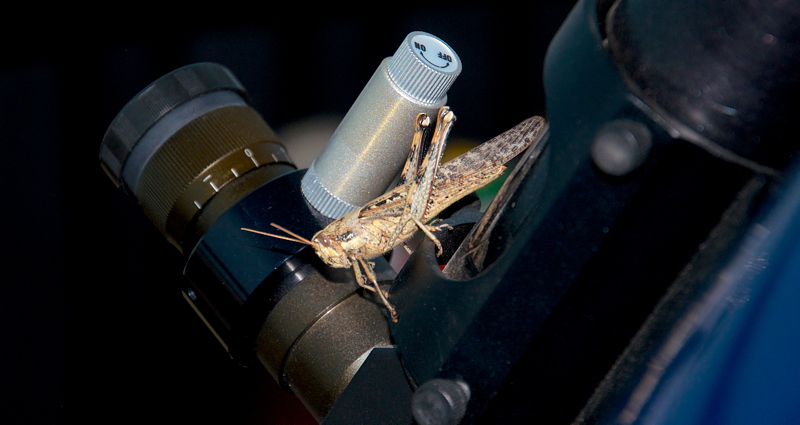A Visitor, iPhone Uranus and Jupiter, HorseHead Nebula Observing
Posted: 7 February 2015
|
Open: Friday, 6 February 2015, 1811 MST Temperature: 76°F |
Session: 777 Conditions: Clear |
Upon uncovering the 8" telescope I saw that I had a visitor in the observatory:

He (she?) liked the perch and didn't want to leave there. I finally convinced him (her?) that she would be safer outside the observatory.
1819 MST: viewed Venus, 83X and 166X. A slight gibbous phase was visible using 166X. Then viewed Uranus, 166X. Small disk visible. Began setting up for iPhone 5s afocal imaging of Uranus. Seeing was not very good however. First tried using 444X but Uranus was too faint for slo-mo video recording. Switched to 222X and with full digital zoom and a full brightness exposure setting I was able to get some normal video recordings. This is a stack of 290 frames:

1910 MST: the Zodiacal Light was easily seen, going almost to the zenith. The Winter Milky Way was also nicely visible.
1915 MST: at the request of a web site visitor I did some tests using my Nikon DSLR DG-2 Eyepiece Magnifier (2X) on my 12x70 binoculars. As I expected, it worked. What I didn't expect was that the image quality was very good. That might be due to it being a Nikon magnifier. The disk of Venus was obvious. The 4 Jupiter moons were easily seen. (They were also easy without the magnifier.) But as I had guessed, the field-of-view was restricted. In fact it was way worse than I expected. Without the magnifier I could see the 3 Orion belt stars and M42 in the FOV. With the magnifier only M42 was visible in the FOV. But it was a nice view of M42. Without the magnifier all of the Pleiades stars were well within the FOV. With the magnifier only a few stars were in the FOV. The amount of the FOV restriction will depend on the design of the magnifier. Mine is long. Shorter ones may have more FOV visible. For some purposes, using a camera viewfinder magnifier on one side (or both if you have two of the same magnifiers) may be useful. Ideally you would have some way of attaching the magnifier(s) to the eyepiece(s) as holding it with your hand makes using a magnifier difficult.
1937 MST: viewed M42 (Orion Nebula), 83X. I then began trying to observe the Horsehead Nebula. I have seen it previously with my 8" LX200-ACF but it is a difficult object. On all my recent attempts I have failed, but I wanted to try again. I tried 83X, with and without 2" UHC and 2" Urban Sky filters. No luck. Switched to a 1.25" 26mm eyepiece (77X) in order to try using a Hydrogen-Beta filter. Again no luck. Switched to my William Optics Binoviewers (100X) (no filter used), thinking that maybe using both eyes would help. I could easily see the line of nebulosity and some dark patches by the Horsehead, but could not make out a "horse head". Then tried a 2" 9mm 100° eyepiece (222X) (no filter); nebulosity and a dark area was visible, but again, no "horse head". Switched back the 2" 24mm UWA eyepiece (83X) (no filter) and after several minutes of observing, at 2018 MST I finally picked up a "horse head". It was just barely visible using averted vision.
2020 MST: eastern sky was now beginning to brighten due to the rising waning gibbous moon.
2025 MST: viewed Jupiter and its four bright moons, 83X. Seeing was not very good. Switched to using the Binoviewers (100X); very nice view of the planet and moons. Added the 1.6X Barlow Lens; disks of all four moons were visible. Using the Binoviewers to observe Jupiter was a joy.
2036 MST: began preparing to image Jupiter using the iPhone 5s. This is a stack of 1782 frames (15 seconds) using Keith's Image Stacker from a slo-mo video (120 fps), 444X, using full digital zoom in the Camera app:

And this is a single frame afocal photo, 222X, showing the four Galilean Moons (Jupiter is overexposed):

|
Close: Friday, 6 February 2015, 2115 MST Temperature: 58°F |
|
Comments are welcome using Email. If you are on Twitter you can use the button below to tweet this report to your followers. Thanks.
Cassiopeia Observatory Home Page
Copyright ©2015 Michael L. Weasner / mweasner@me.com
URL = http://www.weasner.com/co/Reports/2015/02/07/index.html
